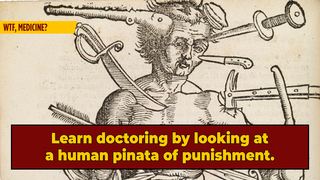Meet 'Wound Man,' The IKEA Instruction Manual Of Medieval Surgery

In the Middle Ages, being treated by your local physician was like playing Russian roulette with five of the six chambers being loaded with leeches. So in the late Medieval period, medical experts sought to improve the overall medical literacy of healers -- not an easy feat since half of them couldn't actually read. So they needed something simpler than an advanced academic medical treatise, something more akin to a fun cartoon that teaches horrible pain and death. And what they came up with was Wound Man.

First published in the 14th century, Wound Man was a surgical illustration aimed to teach injury types to all levels of medical practitioners -- from doctors to barber-surgeons to the swamp witch that trades fertility potions for baby teeth. As such, Wound Man is shown to simultaneously be getting shot, stabbed, bludgeoned, and be-plagued to quickly inform readers of the most common ailments of the time. Like a listicle of the 30 Most Popular Medieval Ways To Get Sepsis.

At first, this Dark Age infographic was very rudimentary. Next to Wound Man's many gaping wounds was written a brief description of the type of injury and if the affliction was "curable or incurable." This informed the busy healer of which injuries were beyond their skill and death was guaranteed. Like the plague. Or a particularly large splinter. But over his dozen or so distinct appearances in medical pamphlets, Wound Man's purpose evolved significantly. Like an index of human misery, later Wound Men had numbers placed next to each injury to act like a Medieval Microsoft Paperclip guiding readers to a more elaborate treatment description further in the pamphlet.

As medicine advanced into more enlightened ages, the practical use of Wound Man dwindled. But it's imagery was so iconic that it found a new purpose: marketing. Later medical authors would often emblazon the covers of their pamphlets with highly stylized versions of this mascot of misery as if to advertise: "Look at all the nasty shit I can cure in this book." He even came with his own set of marketing slogans, like in the German Feldtbuch der Wundartzney: "When I've been hit in hip or thigh and wounded so that death is nigh I hope that God will stand by me and grant me Gersdorff's surgery." It's probably more catchy in German.
You can follow Cedric on Twitter, the Wound Man of social media.
Top Image: The Wellcome Library